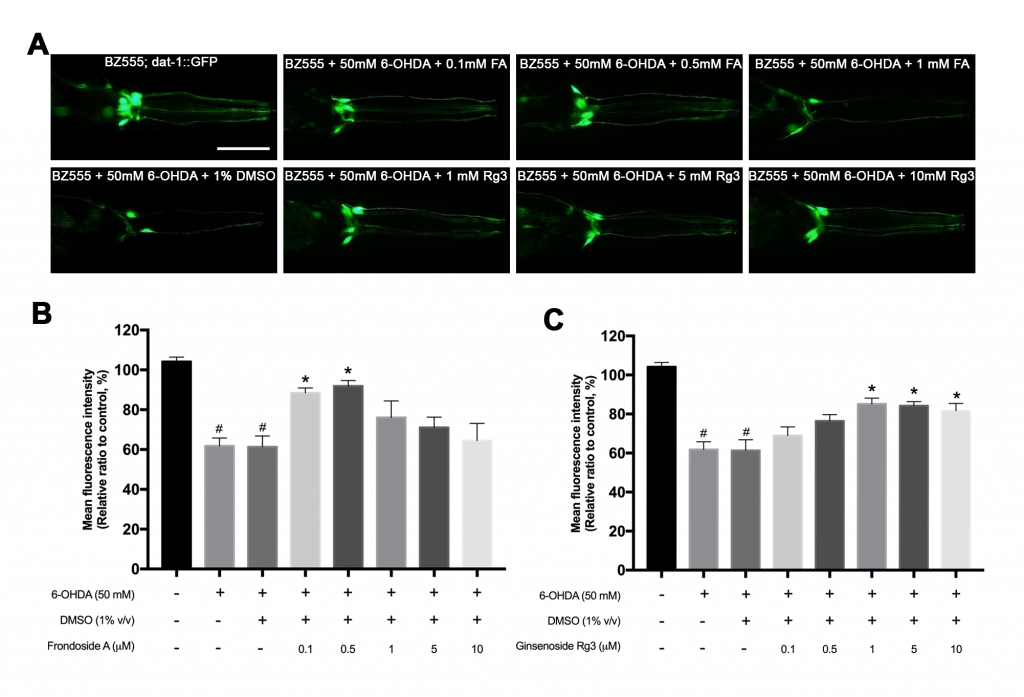
ฤทธิ์ของ Frondoside A และ Ginsenoside Rg3 ในการฟื้นฟูเซลล์ประสาทจากโรคพาร์กินสันในสัตว์ทดลองต้นแบบ Caenorhabditis elegans
Highlight:
สาร frondoside A จากปลิงทะเล และ ginsenoside Rg3 จากโสม สามารถลดการฟื้นฟูเซลล์ประสาทจากการถูกทำลาย และลดการเกาะกลุ่มของโปรตีนแอลฟ่าซิลนิวคลิอิน ซึ่งเป็นสาเหตุหลักของโรคพาร์กินสัน โดยสารสกัดทั้งสองออกฤทธิ์ในการยับยั้งกระบวนการ apoptosis การกระตุ้นเอ็นไซม์ต้านอนุมูลอิสระ และกระตุ้นกระบวนการย่อยสลายโปรตีนที่ผิดปกติภายในเซลล์
ที่มาและความสำคัญ
โรคพาร์กินสันเกิดจากการสูญเสียเซลล์ประสาทสร้างโดปามีนและการสะสมของโปรตีนแอลฟ่าซิลนิวคลิอินในเซลล์ โดยในปัจจุบันยังไม่มีการรักษาโรคพาร์กินสันอย่างมีประสิทธิภาพ และการรักษาที่มีอยู่เป็นเพียงการประคับประคองและรักษาตามอาการที่เกิดขึ้นเท่านั้น ซึ่งมีผลการศึกษาที่ผ่านมาพบว่าสารสกัดซาโปนินมีผลในการป้องกันเซลล์ประสาทในโรคความเสื่อมของระบบประสาทได้ ซึ่งสารสกัดซาโปนินนี้สามารถพบได้ในโสมและปลิงทะเล แต่ยังไม่มีการศึกษาที่ชัดเจนถึงกลไกดังกล่าว ในการศึกษาวิจัยนี้จึงได้ทำการศึกษาการออกฤทธิ์ป้องกันเซลล์ประสาทในการต้านโรคพาร์กินสันของสารสกัด frondoside A จากปลิงทะเล และ ginsenoside Rg3 จากโสม ในสัตว์ทดลองต้นแบบ C. elegans โดยผลการทดลองพบว่าสารสกัด frondoside A และ ginsenoside Rg3 สามารถลดการทำลายของเซลล์ประสาทสร้างโดปามีน และฟื้นฟูพฤติกรรมการหาอาหารซึ่งเป็นหน้าที่หลักของสารสื่อประสาทโดปามีนใน C. elegans รวมถึงการยืดอายุขัยเฉลี่ยของ C. elegans ได้ ซึ่งกลไกนี้เกิดขึ้นจากการลดกระบวนการ apoptosis และการเพิ่มขึ้นของยีนต้านอนุมูลอิสระ นอกจากนี้สารสกัด frondoside A ยังสามารถลดการเกาะกลุ่มกันของโปรตีนแอลฟ่าซิลนิวคลิอิน โดยกระตุ้นผ่านทางกลไกการย่อยโปรตีนที่ผิดปกติภายในเซลล์ ดังนั้นงานวิจัยนี้จึงแสดงให้เห็นถึงประสิทธิภาพของสารสกัด frondoside A และ ginsenoside Rg3 ในการฟื้นฟูเซลล์ประสาทจากการถูกทำลาย และลดการเกาะกลุ่มของโปรตีนแอลฟ่าซิลนิวคลิอิน ซึ่งจะนำไปสู่การใช้ประโยชน์ของสารสกัดในการป้องกันรักษาโรคพาร์กินสันต่อไป
Abstract
Parkinson’s disease (PD) is a currently incurable neurodegenerative disorder characterized by the loss of dopaminergic (DAergic) neurons in the substantia nigra pars compacta and α-synuclein aggregation. Accumulated evidence indicates that the saponins, especially from ginseng, have neuroprotective effects against neurodegenerative disorders. Interestingly, saponin can also be found in marine organisms such as the sea cucumber, but little is known about its effect in neurodegenerative disease, including PD. In this study, we investigated the anti-Parkinson effects of frondoside A (FA) from Cucumaria frondosa and ginsenoside Rg3 (Rg3) from Panax notoginseng in C. elegans PD model. Both saponins were tested for toxicity and optimal concentration by food clearance assay and used to treat 6-OHDA-induced BZ555 and transgenic α-synuclein NL5901 strains in C. elegans. Treatment with FA and Rg3 significantly attenuated DAergic neurodegeneration induced by 6-OHDA in BZ555 strain, improved basal slowing rate, and prolonged lifespan in the 6-OHDA-induced wild-type strain with downregulation of the apoptosis mediators, egl-1 and ced-3, and upregulation of sod-3 and cat-2. Interestingly, only FA reduced α-synuclein aggregation, rescued lifespan in NL5901, and upregulated the protein degradation regulators, including ubh-4, hsf-1, hsp-16.1 and hsp-16.2. This study indicates that both FA and Rg3 possess beneficial effects in rescuing DAergic neurodegeneration in the 6-OHDA-induced C. elegans model through suppressing apoptosis mediators and stimulating antioxidant enzymes. In addition, FA could attenuate α-synuclein aggregation through the protein degradation process.
KEYWORDS: Parkinson’s disease, dopaminergic neurons, neurodegeneration, α-Synuclein, frondoside A, ginsenoside Rg3, Caenorhabditis elegans
Citation: Chalorak, P.; Sanguanphun, T.; Limboonreung, T.; Meemon, K. Neurorescue Effects of Frondoside A and Ginsenoside Rg3 in C. elegans Model of Parkinson’s Disease. Molecules2021, 26, 4843. https://doi.org/10.3390/molecules26164843
RELATED SDGs:
SDG Goal หลัก ที่เกี่ยวข้อง
3. GOOD HEALTH AND WELL-BEING

ผู้ให้ข้อมูล: รองศาสตราจารย์ ดร.ไกร มีมล
ชื่ออาจารย์ที่ทำวิจัย: รองศาสตราจารย์ ดร.ไกร มีมล
ชื่อนักศึกษาที่ทำวิจัย: Pawanrat Chalorak, Tanatcha Sanguanphun
แหล่งทุนวิจัย: Mahidol University (Basic Research Fund: fiscal year 2021)
ภาพถ่าย: รองศาสตราจารย์ ดร.ไกร มีมล
Tags: Caenorhabditis elegans, dopaminergic neurons, frondoside A, ginsenoside Rg3, neurodegeneration, Parkinson’s Disease, α-Synuclein
